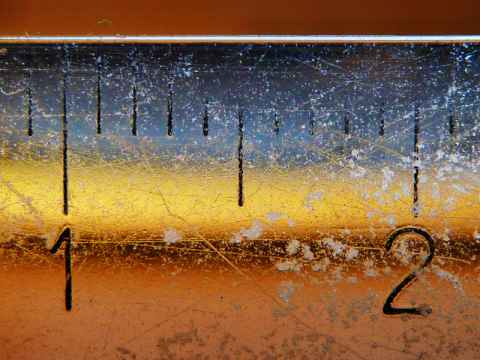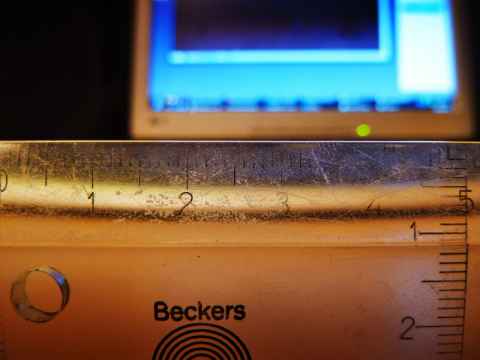When doing macro photography (taking pictures of small things), one important factor is just what magnification the lens is capable of. This is called the reproduction ratio and is the ratio formed by the size of the image of the object that hits the sensor or film divided by the real-life size of the object being photographed. "Macro" lenses are those with a reproduction ratio of 1:1 or higher.
So, suppose you have a camera with a sensor that is exactly 1 x 1 cm. Then you have an object that is also 1 x 1 cm (say, a 1 x 1 cm piece of paper). If your lens can focus close enough to make that object precisely fill the whole image area and still be in focus - congratulations! You have a 1:1 true macro lens.
Suppose now that the closest your lens can focus is when the object fills half the width of the image (and 1/4 of the area): Then you have a maximum reproduction ratio of 1:2.
If you have a camera and lens combination you can easily figure out the reproduction ratio this way:
-
Find some object that has a real-world measure on it, like a ruler.
-
By moving the camera closer or farther away, by zooming in and out, try to find the combination of distance and zoom that will make the real-world object as large as possible while still being in focus.
-
Snap a picture and open it in a photo editor of your choice.
-
Select two points on the object whose real-world separation is known. Call this real-world horizontal distance in mm Dreal. Count the number of horizontal pixels between them and call this count Pobject. The higher the values, the better.
-
Look up the size of the camera's sensor in mm. Call the width of the sensor Wsensor. Jot down the width of the full image in pixels and call this Pimage
-
Knowing these three values, we can figure out the reproduction ratio. First, we figure out what on-sensor distance, Dsensor, Dreal corresponds to:
(eq.1)Dsensor = Wsensor Pobject / Pimage
-
Then, the ratio is simply:
(eq.2)Reproduction ratio = Dsensor / Dreal.
Three things about the table below:
-
Due to the smaller sensor in the TZ7, the ratios don't correspond to the same visual result as they would have on a 35mm camera. This is because even at a lower reproduction ratio, the object will fill the frame of the little sensor. I have therefore also computed the 35mm equivalent reproduction ratios, just for comparison. These are the reproduction ratios you'd have to have on a macro lens attached to a 35mm camera in order to get the same visual result, and are listed in the "Macro Zoom, 35mm" and "Macro, 35mm" columns. The ratios as they are with the small sensor are under "Macro Zoom, actual" and "Macro, actual".
-
The TZ7 has two macro modes: Macro and Macro Zoom. The zoom mode is a 3x digital zoom, with all the caveats that implies. If you don't know what caveats it implies, just ignore those columns - it is possible to make use of that mode, but you have to know the tradeoffs.
-
If nothing of the above makes any sense, just focus on the rightmost column, "Macro, 35mm".
| Macro Zoom, actual | Macro Zoom, 35mm | Macro, actual | Macro, 35mm | |
|---|---|---|---|---|
| Image width (px) | 3648 | 3648 | 3648 | 3648 |
| Measurement (mm) | 10 | 10 | 35 | 35 |
| Measurement (px) | 2656 | 2656 | 2504 | 2504 |
| Sensor width (mm) | 6.13 | 36 | 6.13 | 36 |
| Measure on sensor (mm) | 4.46 | 26.21 | 4.21 | 24.71 |
| Reproduction ratio | 1:2.24 | 2.62:1 (1:0.38) | 1:8.32 | 1:1.42 |
Test Images
Comparison With Other Lenses
To see how the TZ7 stacks up, I looked up some common lenses for Nikon DX. Of course, if you are into macro photography and own a (D)SLR, you can go out and get a real macro lens. The 35mm equivalent for DX lenses assumes you put the lens on a DX camera (crop factor 1.5). We see that the TZ7 stacks up quite nicely against non-macro (D)SLR lenses, but is trounced by the true macro lens.
| Lens | Ratio (actual) | Ratio (35mm) |
|---|---|---|
| Nikon 105mm Micro-Nikkor | 1:1.0 | 1:1.0 |
| Panasonic TZ7 | 1:8.3 | 1:1.4 |
| Nikon 18-55mm II DX | 1:3.2 | 1:2.1 |
| Nikon 55-200mm DX | 1:4.3 | 1:2.9 |
| Sigma 55-200mm DX | 1:4.5 | 1:3.0 |

